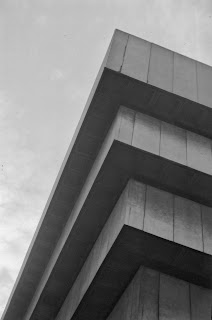Quotes from Steven Gartside, Model Forms: Sculpture / Architecture in 50s & 60s’ Britain
(Henry Moore Institute, 2002) [Henry Moore Institute Essays on Sculpture – 37]
If nothing were missing, there would be no reason for the model’s
existence. Thus, the viewer is invited to play a role of speculation, tracing
threads towards an imagined end.
We see in the photograph above anonymous officials
considering the model before them of John Madin’s proposed Civic Centre for
Birmingham which in 2016 is currently being demolished.
The model is part of a curtailed language structure – an
expression of the context of its time. It is also part of a communication
system that is ultimately only partially effective. It could even be said that
the model comments on the practice of architecture and sculpture, by operating
as a meta-architecture or a meta-sculpture. To produce a model is the process
of making the unformed formed. What exists in the mind, and through a
collection of other expressions, has to be turned into physical form, but not
necessarily the final form. It is here that the central act of translation has
to occur; with the caveat that this is not all there is.
The model is an acknowledgement of a position within the
process of production. The viewer is presented with something that, out of
time, has no official / real state.
Madin’s model is an ideal and the final building its shadow.
The distortion in the transformation / correspondence to reality was brought
about by spending cuts at Birmingham City Council in the 1970s.
In theory, the model allows for the production of a state
of grace – the object unfettered by the everyday limitations of ‘real’
existence.
If the model is an object, then what kind of object is it?
Its existence, when viewed in isolation, has a certain uniqueness – complete,
yet incomplete, a model form of something else, without context or mitigating
circumstance. There is a kind of freedom in the model – one primarily connected
to its indeterminacy as an object. Its freedom denies a conventional system of
value, because the object is removed from systems of consideration. The level
of the indeterminate is extended by the possibility of relating the model
either to origin (thought) or to eventuality (finished work.)
Madin’s model has made the officials appear like seated
gods judging the fate of the world far beneath them. However, their presence
in the photograph is also a ‘reproach to idealisation’ by giving it a real,
human context – completing the symbol.
In this way the model can move towards a fictive state – a
narrative begun by the maker to be completed by the viewer. This allows the
viewer a way out of a destructive endgame, one that fails to move outside the
model as an incomplete project. To encourage the viewer to imagine a range of
likely outcomes for the final work could be seen as bypassing the conditions of
museum purpose. It is, perhaps, the same as the use of narrative in history
paintings – the object is finished, but it is difficult not to make the image
move on in the mind. Narrative impulse is strong, and can be the perfect
complement to indeterminacy.
Context provides architecture with the experience of dirty
realism – the messy fractures in control that everyday experience brings. In a
mass of schemes and developments, only a few can escape relatively unscathed
from the compromising realities of use. Space is transitory, place has a
central core of permanence. Idealised space is fine, non-existent space invents
its own rules. In the production of actual space, time is crucial. The marks of
time are not those of material against environment. Time is about the loosening
of control – idealised space being replaced by real space. Model forms allow us
to take a step out of that. Not a step backwards, rather a step outside time – an
immersion in space, or spatial concepts. The relief is temporal, as the dirty
realism of everyday life waits to exert its presence with slow, even power.






